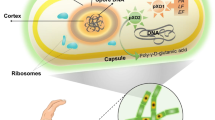Abstract.
Anthrax is a disease of herbivores caused by the gram-positive bacterium Bacillus anthracis. It can affect cattle, sheep, swine, horses and various species of wildlife. The routes for the spread among wildlife are reviewed. There are three kinds of human anthrax – inhalation, cutaneous, and intestinal anthrax – which differ in their routes of infection and outcomes. In the United States, confirmation of cases is made by the isolation of B. anthracis and by biochemical tests. Vaccination is not recommended for the general public; civilians who should be vaccinated include those who, in their work places, come in contact with products potentially contaminated with B. anthracis spores, and people engaged in research or diagnostic activities. After September 11, 2001, there were bioterrorism anthrax attacks in the United States: anthrax-laced letters sent to multiple locations were the source of infectious B. anthracis. The US Postal Service issued recommendations to prevent the danger of hazardous exposure to the bacterium. B. anthracis spores can spread easily and persist for very long times, which makes decontamination of buildings very difficult. Early detection, rapid diagnosis, and well-coordinated public health response are the key to minimizing casualties. The US Government is seeking new ways to deter bioterrorism, including a tighter control of research on infectious agents, even though pathogens such as B. anthracis are widely spread in nature and easy to grow. It is necessary to define the boundary between defensive and offensive biological weapons research. Deterring bioterrorism should not restrict critical scientific research.
Similar content being viewed by others
Author information
Authors and Affiliations
Additional information
Electronic Publication
Rights and permissions
About this article
Cite this article
Atlas, .R. Responding to the threat of bioterrorism: a microbial ecology perspective – the case of anthrax. Int Microbiol 5, 161–167 (2002). https://doi.org/10.1007/s10123-002-0084-x
Received:
Accepted:
Issue Date:
DOI: https://doi.org/10.1007/s10123-002-0084-x




